Xin Q. Diesel Engine System Design
Подождите немного. Документ загружается.

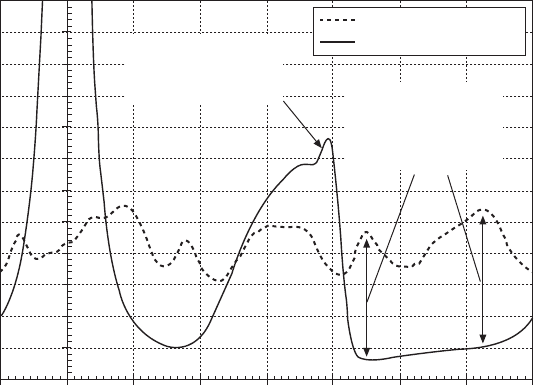
428 Diesel engine system design
© Woodhead Publishing Limited, 2011
Impact of exhaust brake gas loading on valvetrain
The potential impact of the exhaust brake operation on the valvetrain
can be summarized as follows on the gas load acting on the valvetrain
components:
1. Excessive exhaust valve oating in the intake or compression stroke.
2. Exhaust valvetrain separation near the BDC in the exhaust stroke.
3. High exhaust cam force and stress near the end of the exhaust
stroke.
4. High intake cam force at the beginning of the intake stroke.
5. Intake valvetrain separation caused by high recompression pressure.
Figure 6.7 shows that there are two exhaust pressure pulses in the early
portion of the intake stroke (360–540°) and the compression stroke (540–0°),
respectively. These pulses may overcome the cylinder pressure and the exhaust
valve spring preload so that the exhaust valve momentarily re-opens and
closes abruptly with bouncing and uncontrolled high valve seating velocity,
if the exhaust manifold pressure is too high. Moderate exhaust valve oating
is acceptable (Schmitz et al., 1992), but not excessively large. The valve
oating also causes other durability problems such as the fretting of the
valve stem, the keeper and the retainer.
Exhaust port pressure
Cylinder pressure
High recompression
pressure caused
by high exhaust
manifold pressure
These pulses of
pressure difference
can make the
exhaust valve float
off the valve seat.
–90 0 90 180 270 360 450 540 630
Crank angle (degree)
Pressure (bar, absolute)
12
11
10
9
8
7
6
5
4
3
2
1
0
6.7 I6 engine exhaust port pressure pulse with conventional exhaust
brake (2600 rpm).
Diesel-Xin-06.indd 428 5/5/11 11:50:31 AM
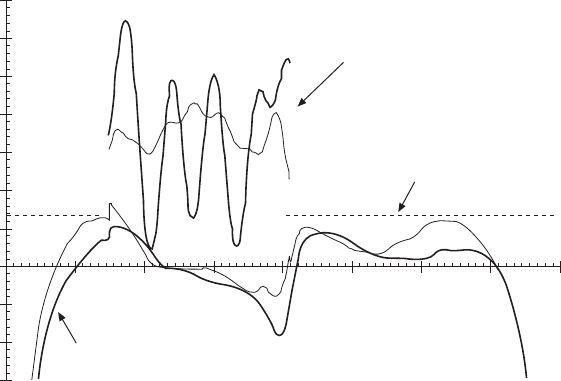
429Engine brake performance in diesel engine system design
© Woodhead Publishing Limited, 2011
Figure 6.7 also shows that there is a high recompression pressure around
the 360∞ valve overlap TDC during exhaust braking at high engine speeds. The
high recompression pressure is caused by high exhaust manifold pressure. The
recompression pressure excites the violent vibration of the intake valvetrain
so that the intake peak pushrod force or cam force can become excessively
high just after the valve overlap TDC, and intake valvetrain separation may
occur.
Figures 6.8 shows the net gas force acting on the exhaust valve during one
engine cycle of the exhaust brake. The positive net gas force tends to push
the exhaust valve open, while the negative net gas force tends to push the
valve to close (or to increase the pushrod force). It is observed that during
the exhaust cam event, the effect of the net gas loading in exhaust braking is
to aggravate the exhaust valvetrain separation at high speeds near the BDC
(e.g., at 190∞ crank angle), and to increase the exhaust cam force and stress
at the end of the exhaust stroke. The exhaust cam stress increase in exhaust
braking is shown in Fig. 6.9. During the intake and compression strokes,
the effect of exhaust braking is to cause the exhaust valve oating, high
intake pushrod force or cam force, and intake valvetrain separation induced
by the high recompression pressure. The above valvetrain dynamics issues
limit the retarding power of the exhaust brake. Figure 6.10 summarizes these
constraints imposed by the valvetrain design.
Cam force (without gas
load) at 3000 rpm (thinner
curve) and 4500 rpm
(thicker curve)
Net gas load threshold
beyond which the exhaust
valve floats off the valve seat
Net gas load on the exhaust valve of the worst cylinder during
exhaust braking at 3000 rpm (thinner curve) and 4500 rpm
(thicker curve)
Influence of V8 exhaust-brake instantaneous pressure on
valve floating and valvetrain dynamic no-follow
0 90 180 270 360 450 540 630 720
Crank angle (degree) Note: The firing TDC is at zero degree.
Force (N)
3500
3000
2500
2000
1500
1000
500
0
–500
–1000
–1500
6.8 Impact of V8 exhaust manifold pressure on valvetrain
performance with exhaust brake.
Diesel-Xin-06.indd 429 5/5/11 11:50:31 AM

430 Diesel engine system design
© Woodhead Publishing Limited, 2011
Exhaust valve oating analysis
A detailed analysis of the exhaust valve oating is provided as follows. The
exhaust valve oating dynamics can be analyzed based on a force balance
in the following:
Exhaust cam stress in exhaust brake
Cam stress at 3000
rpm with gas load
Cam stress at 4500
rpm with gas load
Cam stress at the
cranking speed
Cam stress at 4500
rpm without gas load
0 90 180 270 360 450 540 630 720
Crank angle (degree)
Cam stress (psi)
300,000
250,000
200,000
150,000
100,000
50,000
6.9 Impact of exhaust braking on cylinder pressure gas loading and
exhaust cam stress.
Engine retarding power at
VGT vane very closed
Valvetrain limit
(no-follow, peak force)
Exhaust valve
float limit
Engine retarding power
at VGT vane fully open
Engine speed
Exhaust brake retarding power
6.10 Engine exhaust brake design constrained by valvetrain limits.
Diesel-Xin-06.indd 430 5/5/11 11:50:32 AM

431Engine brake performance in diesel engine system design
© Woodhead Publishing Limited, 2011
ml
FK
lp
Ap
VAL
ml
VAL
ml
VAL
pr
FK
pr
FK
es
FK
es
FK
Sp
lp
VAL
lp
cyl
cyl
Ap
cyl
Ap
po
=
FK+ FK
FK
es
FK+ FK
es
FK
lp+ lp
(–
lp(–lp
Ap(–Ap
cyl
(–
cyl
Ap
VAL
Ap(–Ap
VAL
Ap
Ap
cyl
Ap(–Ap
cyl
Ap
,,
lp
,,
lp
Ap
,,
Ap
Sp,,Sp
lp
VAL
lp
,,
lp
VAL
lp
cyl,,cyl
Ap
VAL
Ap
,,
Ap
VAL
Ap
(–
,,
(–
lp(–lp
,,
lp(–lp
Ap(–Ap
,,
Ap(–Ap
cyl
(–
cyl,,cyl
(–
cyl
Ap
VAL
Ap(–Ap
VAL
Ap
,,
Ap
VAL
Ap(–Ap
VAL
Ap
rt
rrtr
VAL
por
t
VAL
f
AF
VAL
AF
VAL
AF
VAL
AF
VAL
por
AF
por
t
AF
t
,,
por,,por
t,,t
VAL,,VAL
f,,f
)
AF)AF
,,
)
,,
AF – AF
6.12
where m
VAL
is the exhaust valve mass, l
VAL
is the lift of the oating motion
of the valve, F
pre
is the exhaust valve spring preload, K
s,Sp
is the spring rate
(stiffness), p
cyl
is the in-cylinder pressure, A
VAL,cyl
is the exhaust valve head
area exposed at the in-cylinder side, p
port
is the exhaust port pressure, A
VAL,port
is the exhaust valve area exposed at the exhaust port side, and F
VAL,f
is the
valve stem friction force. This force balance of the exhaust valve indicates
that the valve will oat off its seat once the net gas load overcomes the
spring preload.
As pointed out by Akiba et al. (1981) in their simulation and experimental
analysis of the dynamic motion of exhaust valve oating in the exhaust brake
operation, the valve oating affects engine cycle simulation results and the
predicted exhaust manifold pressure. Therefore, the simulation of the valve
oating and bouncing motions should be interactive or coupled in nature
between the valve dynamics and the engine cycle simulation.
Exhaust runner or manifold design can reduce the peaks in the exhaust
pressure pulses that act on the exhaust valve. The reduced pulses may prevent
the large unacceptable valve oating so that a high retarding power can be
achieved. Akiba et al. (1981) showed that exhaust manifold grouping and
the manifold cross-sectional area had a large impact on the retarding power.
There was also an effect on the pumping loss due to large cylinder-to-cylinder
variations of the exhaust pressure pulses during exhaust braking.
6.3.5 Interaction with turbocharger performance and
compression brakes
The instantaneous exhaust pressure pulses are affected by the use of
compression brakes. For turbocharged engines at low speeds where the
turbine pressure ratio is close to one, or for naturally aspirated engines,
the pulsation amplitude of the exhaust pressure pulses can be reduced if a
compression brake is used in conjunction with an exhaust brake. In this case,
the exhaust braking valve opening can be made smaller to achieve a higher
cycle-average exhaust manifold pressure by targeting for the same limit of
the instantaneous peak pulse value. As a result, a higher retarding power
can be achieved without making the valve oating issue worse. Schmitz
et al. (1992) reported that the retarding power could be 10–15% higher by
using this technique.
The retarding performance of the conventional exhaust brake is also
complicated by turbine performance, especially at high engine speeds. When
the turbine pressure ratio is much greater than 1, if the exhaust brake is
used together with a compression brake at high engine speeds, closing the
Diesel-Xin-06.indd 431 5/5/11 11:50:32 AM
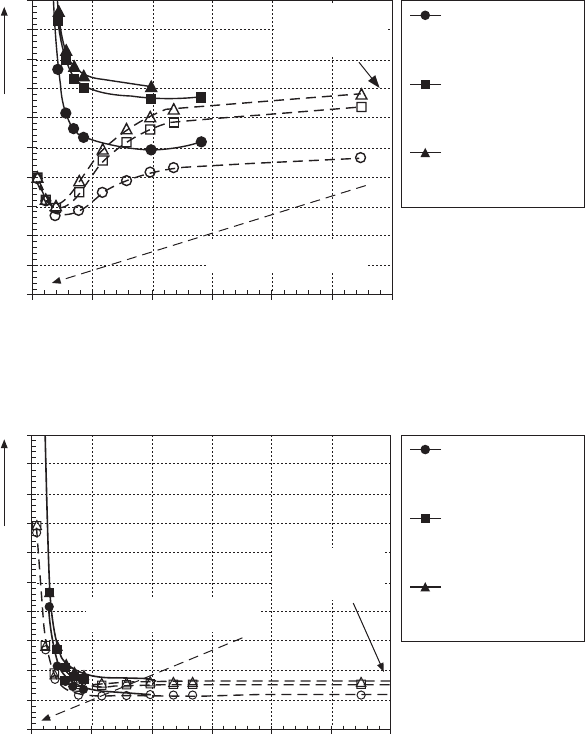
432 Diesel engine system design
© Woodhead Publishing Limited, 2011
exhaust braking valve at the turbine outlet actually results in a reduction in
turbine pressure ratio and air ow rate. As a consequence, both the engine
delta P and the retarding power decrease. When the turbine pressure ratio is
closer to 1, closing the exhaust braking valve leads to a monotonic increase
in engine delta P and retarding power. Figure 6.11 shows the simulation of
such a complex behavior of the exhaust brake and its interaction with the
compression brake.
Braking at 2600 rpm with two-stage turbo, compression-release brake turned on
Retarding power increases
Engine retarding power (hp)
Turbine pressure ratio
decreases from 4 to 1
Post-turbine
exhaust brake
valve fully open
0 1000 2000 3000 4000 5000 6000
Exhaust brake valve effective opening area (mm
2
)
Solid curves:
exhaust brake placed
at HP turbine inlet
Dotted curves:
exhaust brake placed
at LP turbine outlet
HP turbine
wastegate opening
13.5 mm
HP turbine
wastegate opening
6 mm
HP turbine
wastegate fully
closed
Braking at 2600 rpm with two-stage turbo, compression-
release brake turned off
Retarding power increases
Engine retarding power (hp)
Turbine pressure ratio
decreases from 2.5 to 1
Post-turbine
exhaust brake
valve fuly open
0 1000 2000 3000 4000 5000 6000
Exhaust brake valve effective opening area (mm
2
)
Solid curves:
exhaust brake placed
at HP turbine inlet
Dotted curves:
exhaust brake placed
at LP turbine outlet
HP turbine
wastegate
opening 13.5 mm
HP turbine
wastegate
opening 6 mm
HP turbine
wastegate fully
closed
6.11 Interaction between compression brake and conventional
exhaust brake.
Diesel-Xin-06.indd 432 5/5/11 11:50:32 AM
433Engine brake performance in diesel engine system design
© Woodhead Publishing Limited, 2011
6.4 Compression-release engine brake performance
analysis
6.4.1 Types of compression brakes
The types of compression brakes can be classied according to the following
three criteria: (1) the method of how the braking valve motion is controlled
(i.e., valve opening and closing timings precisely timed or not); (2) the
measures used to activate the valve; and (3) whether the valve actuation is
only dedicated to the retarding operation. In the conventional compression
brake, the braking valve’s opening and closing timings are precisely controlled
by mechanical, hydraulic or electromagnetic means and dedicated to the
retarding operation. In the bleeder brake, the braking valve continuously
opens by a small lift amount during either the entire engine cycle or during
the compression, expansion, and exhaust strokes without precisely timed
controls for the valve opening and closing timings. In the exhaust-pulse-
induced compression brake, the braking valve opening and closing timings
are naturally controlled by the available exhaust pressure pulses in the exhaust
port inherent in the engine (i.e., by oating the braking valve) rather than
controlled by a precisely dened mechanical motion such as in the conventional
compression brake. The exhaust-pulse brake can be further classied into
turbine-inlet pulse control brake and turbine-outlet pulse control brake. In the
VVA compression brake, the braking valve’s opening and closing timings
are controlled by a VVA device which is not dedicated only to the retarding
operation (i.e., it is also used for ring). An example of the conventional
brake is the Jake brake. Examples of the bleeder brake are Mercedes-Benz’s
decompression brake (Schmitz et al., 1992) and Navistar’s bleeder brake
used on the I6 engines. Examples of the exhaust-pulse brake are Navistar’s
(including MWM International Motores at Brazil) and MAN’s EVBec type
of brakes (e.g., Barbieri et al., 2010).
These four types of brakes have their own design characteristics and
different constraints. For example, the conventional compression brake
may have a fairly high cam force caused by the high peak cylinder pressure
near the braking TDC acting on the braking valve. This cam force and the
associated cam stress often are the limiting factor for the achievable retarding
power. On the other hand, the exhaust-pulse brake does not have this type
of loading due to its different hydraulic locking mechanism used to produce
the braking valve lift near the TDC. Therefore, it can tolerate a much higher
peak cylinder pressure thus producing a much higher retarding power. These
different types of brakes also have different noise characteristics due to the
difference in the frequency of the exhaust pressure pulses. The conventional
brake is very noisy. The bleeder brake and the exhaust-pulse brake are much
quieter (e.g., by more than 10–15 dBA).
Diesel-Xin-06.indd 433 5/5/11 11:50:33 AM
434 Diesel engine system design
© Woodhead Publishing Limited, 2011
6.4.2 Principles of compression-release brake design
Fundamental mechanisms of compression braking
The design objectives for compression-release brakes include achieving high
retarding power and low-speed torque, variable power levels, low noise,
low weight, low cost, and high reliability while satisfying all the design
constraints such as peak cylinder pressure, component loading, exhaust
manifold gas temperature, and cylinder head component metal temperatures.
Specically, the major design challenges related to braking performance
include the complexity of the following: (1) the valvetrain design for air
ow control; (2) the exhaust system design for noise control; and sometimes
(3) the mechanical loading control.
Compression brake design and performance have been sporadically reported
during the past half a century. The Jake brake design and performance were
introduced by Cummins (1966). The relationship between the turbocharger
and the compression brake was discussed by Morse and Rife (1979). Braking
valve timing/event control for improved retarding performance was addressed
by Meistrick (1992). A development process of the compression brake to
solve the design challenges at Jacobs Vehicle Equipment Company was
described by Freiburg (1994).
The design principles of compression brakes can best be understood by
an in-depth engine cycle simulation since the core of the principles is based
on thermodynamic cycles, volumetric efciency, valve ows, and gas wave
dynamics. As mentioned earlier, the retarding power of a compression brake
consists of the contributions from the indicated strokes and the pumping
loss strokes. In the indicated strokes, the concept of retarding efciency
introduced earlier clearly shows that an increase in the peak cylinder pressure
followed by a fast blow-down is highly desirable in order to increase the
retarding power. Two fundamental mechanisms should be involved in any
high-performance compression brakes. They are the compression-release
mechanism and the braking gas recirculation (BGR) mechanism (Fig. 6.12).
The compression-release mechanism has been well known since the birth
of the rst compression-release brake. The efciency of the compression-
release process at a given intake manifold boost pressure level depends
on the braking valve events (e.g., opening timing and lift prole). Figures
6.13–6.15 illustrate the compression-release process.
The braking gas recirculation (BGR) theory
BGR is a relatively new mechanism related to turbocharged engines discovered
in recent years by a group of researchers at Jacobs Vehicle Systems and the
author at Navistar (Hu et al., 1997b; Yang, 2002; Meistrick et al., 2004;
Xin, 2008). BGR is a technique to supplement the cylinder charge with the
Diesel-Xin-06.indd 434 5/5/11 11:50:33 AM
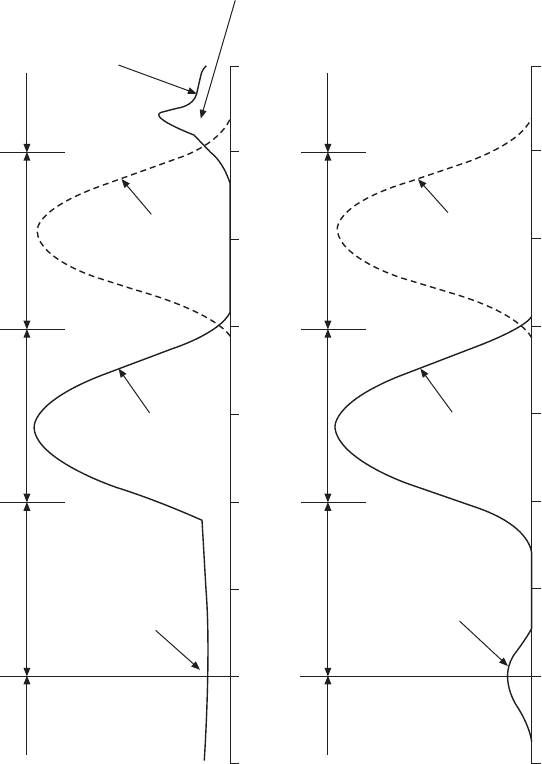
© Woodhead Publishing Limited, 2011
In exhaust-pulse-induced brake,
the braking valve lift is induced
by an exhaust pressure pulse
This is ‘braking gas recirculation’
(BGR), which inducts hot exhaust
gas into the cylinder to enhance
the ‘compression’ effect and
produce hotter gas to feed to the
turbine to generate higher intake
boost pressure
Exhaust-pulse-
induced brake (e.g.,
MANEVBec brake)
Exhaust cam
Exhaust cam
Valve lift Valve lift
Conventional
compression brake
Expansion stroke
Expansion stroke
Exhaust stroke
Exhaust stroke
Intake stroke
Intake stroke
Compression stroke
Compression stroke
Intake cam
Intake cam
–90 0 90 180 270 360 450 540 630
Crank angle (degree)
–90 0 90 180 270 360 450 540 630
Crank angle (degree)
6.12 Mechanisms of compression release engine brakes.
Diesel-Xin-06.indd 435 5/5/11 11:50:33 AM
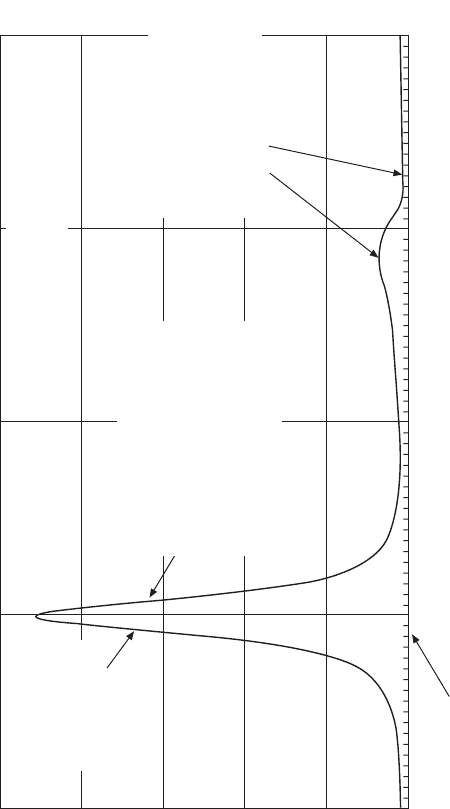
© Woodhead Publishing Limited, 2011
–180 CoMPR 0 PoWER 180 ExHAuST 360 INTAkE 540
BDC TDCF BDC TDC BDC
Crank angle (degree)
The exhaust valve does not open around TDC.
Cylinder pressure (bar)
62.5
50.0
37.5
25.0
12.5
0.0
Note: This is engine motoring without
fueling at 2100 rpm, roducing 88 hp
retarding power
Retarding
power is
produced by
‘compression’
in this stroke
In motoring, there is no
‘release’ process for the
cylinder pressure to decay
quickly. The pressure produces
positive power output in the
expansion stroke to offset
the retarding power in the
compression stroke
These two strokes produce
pumping loss power. Higher
cylinder pressure in the
exhaust stroke or lower
pressure in the intake stroke
gives higher pumping loss
Piston
moves up
Piston
moves down
Piston
moves up
Piston
moves down
6.13 Cylinder pressure trace and engine retarding power produced by pumping loss in motoring.
Diesel-Xin-06.indd 436 5/5/11 11:50:33 AM
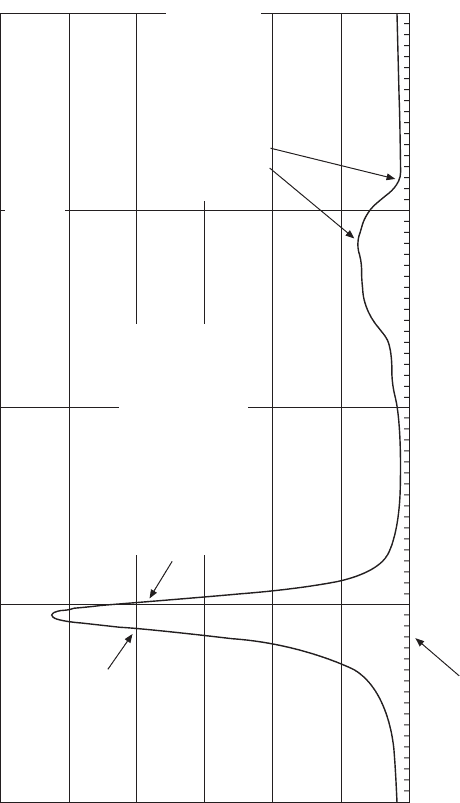
© Woodhead Publishing Limited, 2011
–180 CoMPR 0 PoWER 180 ExHAuST 360 INTAkE 540
BDC TDCF BDC TDC BDC
Crank angle (degree)
The exhaust valve opens around TDC to ‘release’.
Cylinder pressure (bar)
75.0
62.5
50.0
37.5
25.0
12.5
0.0
Retarding
power is
produced by
‘compression’
in this stroke
Piston
moves up
Piston
moves down
Piston
moves up
Piston
moves down
Note: This is compression-release braking
at 2100 rpm, producing 408 hp retarding
power
The pumping loss in these
two strokes contributes much
less than the ‘compression-
release’ effect to the total
engine retarding power
In compression-release engine
brakes, the cylinder pressure
is released quickly to prevent
any significant pressure left in
the expansion (power) stroke
from producing positive power
output
6.14 Cylinder pressure trace and engine retarding power produced by compression brake.
Diesel-Xin-06.indd 437 5/5/11 11:50:33 AM
